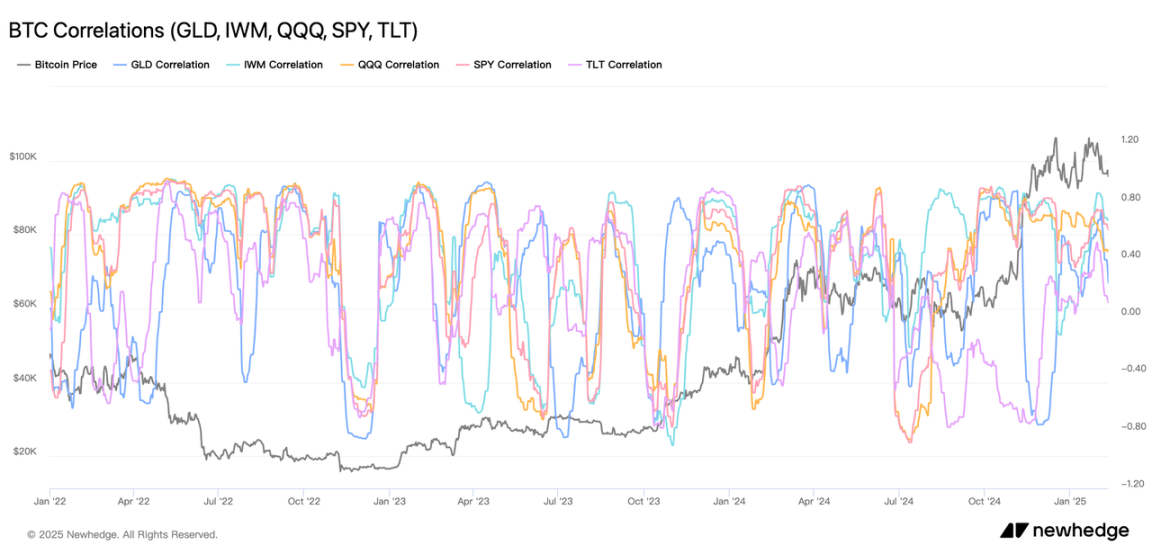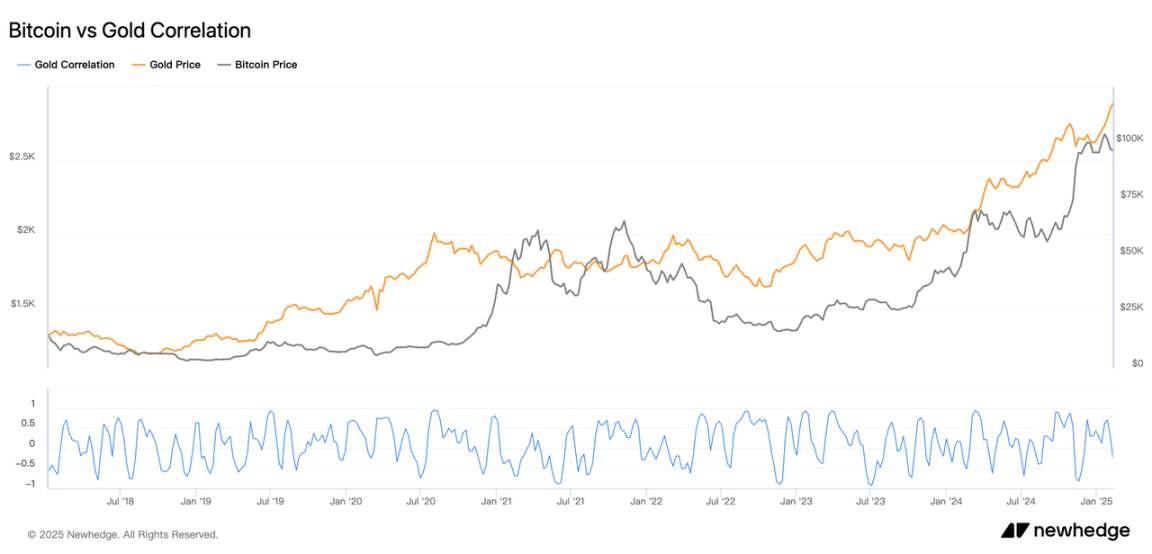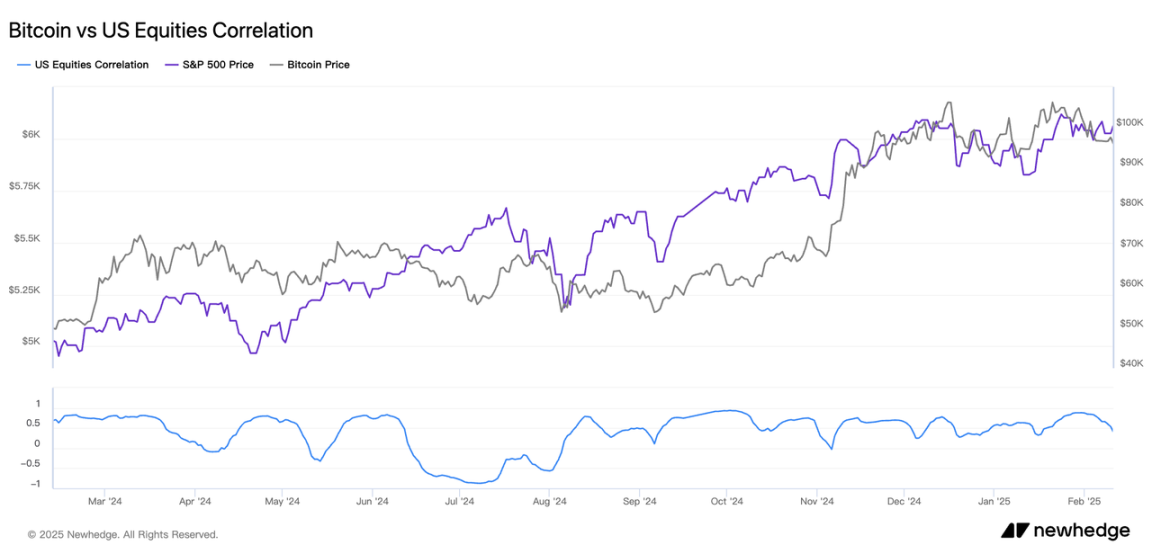Gold prices have repeatedly broken historical highs, why can't Bitcoin "digital gold" work?

Reprinted from panewslab
02/18/2025·2MAuthor: ChandlerZ, Foresight News
At the beginning of 2025, the global capital market fell into a state of ice and fire. Recently, spot gold prices have repeatedly broken new highs. As of February 16, COMEX gold futures price once surged to $2,968 per ounce, with the biggest increase this year approaching 10%, just one step away from the $3,000 mark.
After breaking through the high of $100,000, Bitcoin continued to fluctuate in the range of $90,000-110,000, and the fatigue this year was contrary to the identity of the newly-established safe-haven asset. This fluctuation not only exposes the current pricing logic differences between the two types of assets, but also points to the recalibration of the risk scale by global capital under the "Trump 2.0 era".
Bitcoin vs. Gold: From safe-haven narrative to functional differentiation
The linkage evolution of Bitcoin, US stocks and gold is essentially the drifting process of identity cognition in the process of financialization. As measured by the correlation coefficient between Bitcoin and traditional assets, its correlation shows significant dynamic changes.

As a traditional safe-haven asset, gold has a relatively complex relationship with Bitcoin. Judging from long-term data, the correlation between Bitcoin and gold shows obvious instability, and it frequently fluctuates in the positive and negative range. In the early days, the correlation coefficients of the two were mostly negatively correlated. At that time, Bitcoin was regarded as the "digital" of gold. Alternatives.” However, in the market turmoil after 2022, the two experienced synchronous market trends many times. The correlation in late 2024 tends to be positive, but the fluctuations are still obvious.
This contradiction stems from the differences in the attributes of the two: gold's risk aversion function relies on its physical attributes and historical consensus, while Bitcoin's digital gold narrative relies more on market sentiment and technical expectations. When Bitcoin hit a record high in 2021, gold prices were at a temporary trough. Starting from 2024, the two rose simultaneously due to factors such as the central bank's gold purchase wave and the approval of Bitcoin ETFs. It can be seen that the correlation between the two is driven by phased events rather than an inevitable connection of intrinsic value logic.

US stocks linkage, double helix structure under liquid siphon
In the U.S. stock market, Bitcoin is often classified as a "risk asset", and its price trend shows a significant positive correlation with the Nasdaq Index, which is dominated by technology stocks. This correlation peaked in 2021. The two hit historical highs simultaneously and then pulled back, and hit a bottom and rebounded at the end of 2022, showing consistency of market behavior driven by risk appetite.
The correlation between Bitcoin and the S&P 500 index shows a relatively moderate positive correlation characteristic. The correlation coefficient is mostly maintained between 0 and 0.5. Bitcoin's increase is significantly greater than that of S&P 500, and the price synergy is clearer in the high point area. This relationship was particularly evident in late 2024, when risky assets were generally boosted as expectations of the Fed's turn to a dovish stance heated up.
This synergy even surpassed the negative correlation strength of traditional technology stocks with bonds during the Fed's signal of interest rate cuts. The correlation intensity of the two has exceeded the clustering effect between traditional technology stocks, implying that cryptocurrencies are systematically embedded in the growth stock valuation system. But it is worth noting that this positive correlation shows significant asymmetry: in the market downward cycle, the decline correlation coefficient between Bitcoin and US stocks is not high, revealing its excess risk premium characteristics under the background of high volatility.

This phenomenon can be explained from the perspective of market psychology and liquidity. When global economic expectations improve, investors' risk appetite increases, and funds pour into US stocks and Bitcoin at the same time; and when the market risk aversion is heating up, both may be under pressure. . According to QUICK FactSet data, the total market value of stocks denominated in USD in the world increased by 13.6 trillion US dollars compared with the end of 2023 to US$121.8 trillion, and Bitcoin rose by more than 150% during the same period, confirming that liquidity easing and risk appetite are both joint promotion. However, the high valuation of US stocks also implies the risk of a pullback. If the stock market corrects, Bitcoin may face synchronous pressure, and gold may benefit from safe-haven demand.
Reshaping financial attributes
The linkage between Bitcoin and US stocks and gold reflects the structural changes in crypto market participants. Early Bitcoin was mainly held by retail investors and geek communities, and its price was independent of the traditional financial system. But after 2020, the intervention of institutional investors accelerated its financialization process, making it more susceptible to US stock sentiment. The growth in open contracts for Bitcoin futures on the Chicago Mercantile Exchange (CME) further strengthens this path. In addition, the US SEC's institutional variables such as the approval of Bitcoin spot ETFs and the differences in regulatory policies of various countries also have a long-term impact on the asset attribute positioning of Bitcoin.
The high fluctuations that Bitcoin experienced after breaking through the all-time high of $100,000 are due to the interaction of multiple market forces. On the one hand, investors who entered the market in the early stage gradually cashed in profits at high levels, while new funds brought by institutional channels such as ETFs have been strongly taken over. This increase and decrease in the strength of buyers and sellers has caused prices to fluctuate violently within the range.
On the other hand, the market is still in the brewing period of loose expectations, and large-scale easing has not yet begun. The market is mainly rotated by existing funds between different prices, and the lack of continuous incremental funds entry also limits the upward action after breaking through the new high. able. At the same time, the use of leverage tools such as futures and perpetual contracts is more active, and high leverage amplifies the price fluctuation range, and frequent forced closing of positions further aggravates market fluctuations.
But in general, the reflexive nature of technological innovation is also nurturing new possibilities. Bitcoin is currently being included in the asset-liability management framework of sovereign wealth funds. Appropriate allocation of crypto assets can improve tail risk defense capabilities while maintaining the stability of Sharp rate. This functional evolution indicates that the correlation between crypto assets and traditional assets will present a more complex hierarchical structure, fluctuating as risky assets during the macrostability period, releasing nonlinear associations at the moment of systemic crisis, and ultimately developing independent asset class positioning .
In the myth of Noah's Ark, clean creatures come in pairs, and unclean creatures go their own way. The dilemma between Bitcoin and traditional assets is just like the "financial monster" whose companions cannot be found in the flood of digital civilization. Perhaps this lack of correlation is its true nature. It does not need to benchmark against the millennium hard currency or attaches to the technology bubble, but instead redefines the value coordinates as a different asset native to blockchain.



 chaincatcher
chaincatcher